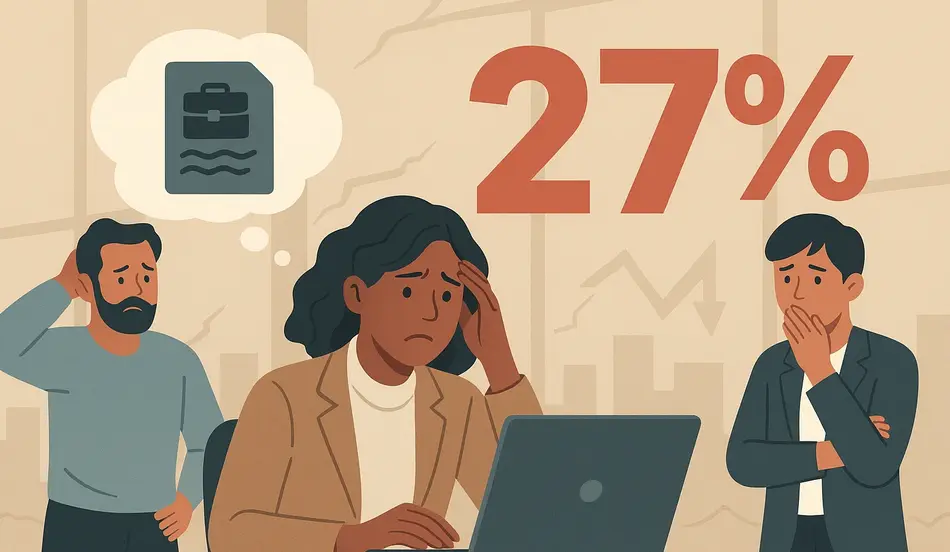In a concerning trend that reflects the evolving nature of the American workforce, job loss anxiety has reached alarming levels across the country. According to a new Bankrate survey released this morning, 27% of workers are more worried about their job security now than they were in January, signaling a significant shift in workplace confidence and economic sentiment.
The Rising Tide of Job Loss Anxiety
The survey reveals a stark reality: nearly three in ten American workers are experiencing heightened anxiety about their employment stability. This represents a dramatic change from just a few months ago, when the job market appeared more stable and predictable.
Job loss anxiety is particularly pronounced among specific demographic groups, with millennials leading the pack in terms of concern. This generational divide highlights the complex interplay between economic conditions, workplace dynamics, and individual career expectations.
Key Findings from the Bankrate Survey
The comprehensive study conducted by Bankrate’s senior economic analyst Mark Hamrick uncovered several critical insights:
- 27% of workers report increased job security concerns since January
- Millennials are disproportionately affected by job loss anxiety
- Lower-income workers (under $50,000) show higher anxiety levels
- Political affiliation influences job security perceptions
- Job search times are taking longer than in previous years
The Millennial Paradox: Why Younger Workers Are Most Concerned
Perhaps the most striking finding is the generational divide in job loss anxiety. Millennials—typically defined as those born between 1981 and 1996—are experiencing the highest levels of employment insecurity despite being in their prime working years.
The Changing Nature of Employment
Mark Hamrick explains this phenomenon by pointing to the fundamental shift in employer-employee relationships over recent decades. “The pacts that existed to some degree between employers and employees decades ago have largely ceased to exist,” he notes.
This transformation has been driven by several factors:
- Decline in Unionization: Traditional labor protections have diminished
- Gig Economy Growth: Rise of contract and freelance work
- Technology Disruption: Automation and AI threatening traditional roles
- Global Competition: Increased pressure from international markets
- Economic Volatility: Frequent market fluctuations and uncertainty
Why Millennials Are Particularly Vulnerable
Millennials entered the workforce during a period of unprecedented change, experiencing:
- The Great Recession of 2008-2009 during their formative years
- Rapid technological advancement that continues to reshape industries
- Student loan debt that limits career flexibility
- Housing market challenges that impact financial stability
- Delayed career milestones compared to previous generations
The Economic Context: From Red Hot to Normalized
To understand the current job loss anxiety, it’s essential to examine the economic journey of recent years. Just a couple of years ago, the job market was described as “red hot,” with unemployment rates in the mid-3% range—historically low levels that created a sense of invincibility among workers.
The Normalization Process
However, what we’re witnessing now is a normalization of the job market. While it hasn’t “fallen out of bed,” as Hamrick puts it, several concerning trends have emerged:
- Longer job search times for unemployed workers
- Increased competition for available positions
- Reduced bargaining power for salary negotiations
- More frequent layoffs across various industries
- Shifting skill requirements due to technological advancement
The Inflation Connection
The previous “red hot” job market was associated with high inflation, creating a suboptimal economic situation. The current normalization process, while necessary for economic health, has created uncertainty among workers who had grown accustomed to a seller’s market for labor.
Political Dimensions of Job Security Concerns
The Bankrate survey reveals an interesting political dimension to job loss anxiety. The data shows that concerns about job security have risen more significantly among Democrats and Independents than among Republicans.
Understanding the Political Divide
This political correlation suggests that:
- Economic policy perceptions influence job security feelings
- Media consumption patterns may affect anxiety levels
- Regional economic conditions vary by political affiliation
- Industry concentration differs across political demographics
- Policy expectations shape employment outlook
Income-Based Anxiety: The $50,000 Threshold
Another critical finding is the correlation between income levels and job loss anxiety. Workers earning under $50,000 annually report significantly higher levels of concern about their job security.
Why Lower-Income Workers Are More Vulnerable
Several factors contribute to this income-based anxiety:
- Limited Savings: Less financial cushion for job transitions
- Skill Specialization: Often in roles more susceptible to automation
- Limited Network Access: Fewer professional connections for job hunting
- Geographic Constraints: Less ability to relocate for opportunities
- Educational Barriers: Limited access to skill development resources
The Generational Advantage: Why Younger Workers Can Thrive
Despite the concerning statistics, there’s a silver lining for millennials and Generation Z workers. According to Hamrick, younger workers are “fortunately in the best position to improve their lot” and “seize upon opportunities in this innovative, dynamic workforce.”
Leveraging Youth and Adaptability
Younger workers have several advantages in the current environment:
- Digital Native Status: Comfort with technology and remote work
- Adaptability: Willingness to learn new skills quickly
- Network Building: Active engagement with professional platforms
- Risk Tolerance: Greater willingness to change careers or industries
- Innovation Mindset: Comfort with disruption and change
Hiring?
Post jobs for free with WhatJobs – connect with candidates actively seeking stability and growth. Whether you’re hiring agile professionals or dependable long-term contributors, WhatJobs helps you find the right talent fast.
Post a Job Now →Practical Strategies for Managing Job Loss Anxiety
While the survey reveals concerning trends, there are concrete steps workers can take to reduce anxiety and improve their career prospects.
Skill Development for Tomorrow
Hamrick emphasizes the importance of continuous learning: “Make sure your skills are where they need to be, not only for today, but for tomorrow.” This includes:
- Technical Skills: Staying current with industry-specific technologies
- Soft Skills: Developing communication, leadership, and problem-solving abilities
- Digital Literacy: Understanding emerging technologies like AI and automation
- Industry Knowledge: Keeping abreast of trends and changes in your field
- Cross-Functional Skills: Building capabilities that transfer across roles
Network Activation and Maintenance
The survey highlights the critical importance of professional networking: “Make sure your networks are activated on a place like LinkedIn and the virtual world, and maintain your contacts.”
Key networking strategies include:
- Regular Engagement: Consistent interaction with professional contacts
- Value Creation: Offering help and insights to your network
- Platform Presence: Active participation on LinkedIn and other professional sites
- Event Attendance: Participating in industry conferences and meetups
- Mentorship: Both seeking and providing guidance to others
Proactive Career Management
Rather than waiting for job loss to occur, workers should take proactive steps:
- Regular Skill Assessment: Evaluate your marketability quarterly
- Industry Monitoring: Stay informed about trends and opportunities
- Financial Planning: Build emergency funds and reduce debt
- Alternative Income: Develop side hustles or freelance opportunities
- Career Planning: Regularly update your career goals and strategies
The Role of Employers in Reducing Anxiety
While individual workers can take steps to manage their anxiety, employers also have a responsibility to create more stable and supportive work environments.
Building Trust and Transparency
Employers can reduce job loss anxiety by:
- Clear Communication: Regular updates about company health and direction
- Career Development: Providing opportunities for growth and advancement
- Fair Compensation: Ensuring competitive and transparent pay structures
- Work-Life Balance: Supporting employee well-being and flexibility
- Skill Development: Investing in employee training and education
Creating Stability in Uncertainty
Even in dynamic industries, employers can provide stability through:
- Clear Performance Metrics: Transparent evaluation criteria
- Advance Notice: Early communication about potential changes
- Support Services: Providing career counseling and transition assistance
- Flexible Arrangements: Accommodating changing employee needs
- Recognition Programs: Acknowledging and rewarding contributions
The Future of Work: Adapting to Change
The current job loss anxiety reflects a broader transformation in the world of work. Understanding these changes can help workers prepare for the future.
Emerging Trends
Several trends are shaping the future of employment:
- Remote Work: Continued expansion of flexible work arrangements
- Automation: Increasing use of AI and robotics in various industries
- Gig Economy: Growth in contract and freelance opportunities
- Skill Evolution: Rapid changes in required competencies
- Global Competition: Increased international competition for jobs
Preparing for the Future
Workers can prepare for these changes by:
- Embracing Technology: Learning to work alongside AI and automation
- Building Resilience: Developing adaptability and problem-solving skills
- Diversifying Income: Creating multiple revenue streams
- Continuous Learning: Committing to lifelong education and skill development
- Network Expansion: Building diverse professional relationships
Conclusion: Navigating Uncertainty with Confidence
While the Bankrate survey reveals concerning levels of job loss anxiety, particularly among millennials, it also provides a roadmap for addressing these concerns. The key is to recognize that while the job market has normalized from its “red hot” state, opportunities still exist for those who are prepared.
The most successful workers will be those who:
- Embrace Change: View disruption as opportunity rather than threat
- Invest in Themselves: Continuously develop skills and knowledge
- Build Networks: Maintain strong professional relationships
- Stay Informed: Monitor industry trends and economic indicators
- Plan Proactively: Take control of their career trajectory
As Mark Hamrick notes, “There’s tremendous opportunity out there,” but workers need to “level set our expectations” and recognize that the current environment requires different strategies than the job market of a few years ago.
The path forward isn’t about eliminating job loss anxiety entirely—it’s about managing it effectively while positioning yourself for success in an evolving workplace.
FAQ Section
What is job loss anxiety and why is it increasing?
Job loss anxiety is the fear and concern about losing one’s employment, and it’s increasing due to economic normalization, longer job search times, and the changing nature of employer-employee relationships. The Bankrate survey shows 27% of workers are more worried about job security now than in January.
Why are millennials experiencing higher job loss anxiety?
Millennials are experiencing higher job loss anxiety because they entered the workforce during periods of economic volatility, face declining job security compared to previous generations, and are dealing with student debt and housing challenges that limit their financial flexibility.
How can I reduce my job loss anxiety?
To reduce job loss anxiety, focus on skill development for tomorrow’s workplace, maintain active professional networks on platforms like LinkedIn, build emergency savings, stay informed about industry trends, and develop alternative income streams or side hustles.
What industries are most stable during economic uncertainty?
Industries most stable during economic uncertainty typically include healthcare, education, government services, essential retail, and technology sectors that support remote work and digital transformation. However, stability varies by specific roles and skill requirements.




